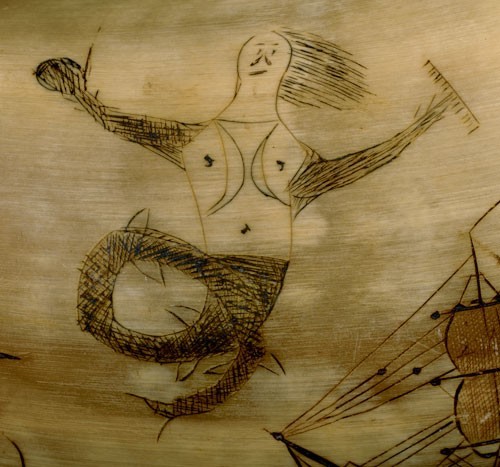
Detail from a powder horn, Jamaica, ca. 1820. (Noël Hume Collection; unless otherwise noted, all photos are by Gavin Ashworth.) This carving depicting a mermaid with the head of a manatee is probably the earliest “mermaid” rendering drawn from life.

Paving tile, England, fourteenth century. Red brick with pipe-clay inlay. Decorated with a mermaid holding a fish, this tile is part of the floor of the library at Litchfield Cathedral. (Photo, courtesy W. W. Rodwell.)
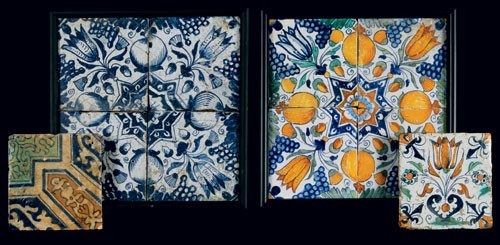
Paving tiles. Left: Netherlands, ca. 1570–1600. White engobe laid on coarse red brick clay; Flemish polychrome. 5" x 5" x 0.71". Found in 1919 in Tower Street, London. The two corner pinholes penetrate .55" into the tile, and the edges are slightly beveled. Center: Two four-tile panels, probably Rotterdam, ca. 1600–1630. Delftware; yellow clay, with tulip and pomegranate designs in monochrome and polychrome. 5.25" x 5.25" x .47". Two pinholes are visible in one of the tiles. Right: Netherlands, ca. 1600–1650. Delftware. 5.19" x 5.19" x .47". Slightly beveled, with polychrome tulip and fleur-de-lis corners and two pinholes.
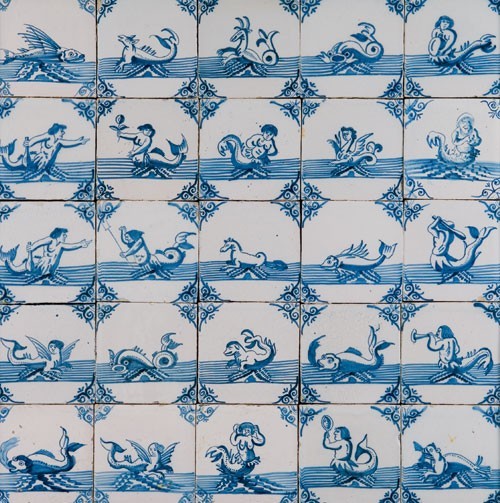
Tile panel, Holland, ca. 1650. Delftware. Dutch tiles were used in panels as well as surrounds.
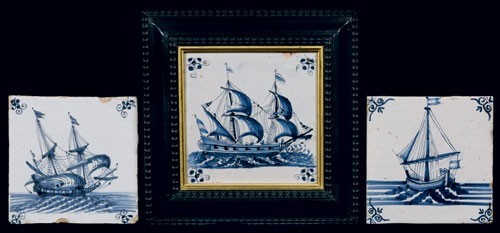
Ship tiles, Holland. Delftware. Left: Ca. 1680–1710. Yellow clay. 4.88" x 5" x .39". Showing a three-masted merchantman under half sail on a rippling sea, this tile has spider corners and two pinholes close to them. Center: Ca. 1650. Pale pink clay. Approx. 5" x 5" (thickness obscured by frame). This depiction of a three-masted warship in full sail with guns run out and four crewmen visible is striking for its realistic treatment of waves and spray and the care taken in drawing the rigging. The tile has spider corners with inset pinholes. Right: Ca. 1650–1700. Orange clay flecked with iron. 4.88" x 4.88" x .31". This tile illustrates a single-masted pinnace with two crewmen and a chevron sea. There is a pinhole .55" in from two of the oxhead corners.

Tile, Holland, ca. 1650–1700. Delftware; yellow clay. 5" x 5" x .43". The tile, which depicts three men seated in a rowboat, one wearing a fur hat, has oxhead corners and no visible pinholes; the edges are slightly beveled. The painting is crude and the colors diffuse.

Tile, Holland, ca. 1625–1650. Delftware; orange clay with iron inclusions. 5.27" x 5.27" x .43". Represented here is an aged Poseidon looking somewhat distraught. He is seated on an orb (possibly a pearl) and holding a sail while riding on a seashell pulled by a reined otter. The subject is outlined in manganese and filled in with two tones of pale blue. The sea and its spray are similarly treated. At each of the spider corners is an inset pinhole.
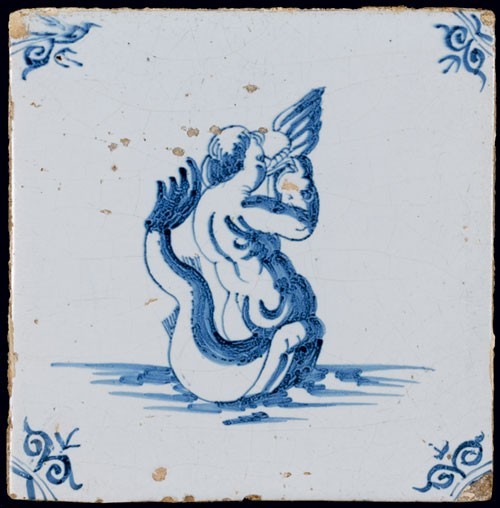
Tile, Holland, ca. 1680–1710. Delftware. 5" x 5" x .43". The standard Triton, shown here blowing into a seashell, is painted in two-tone blue. The tile has oxhead corners, two of which have inset pinholes, on a pink to yellow body with beveled edges.
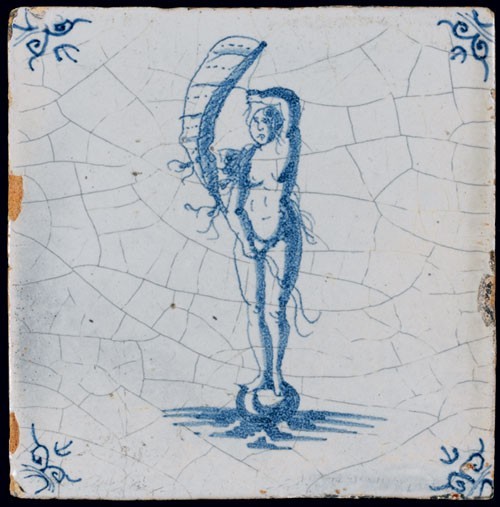
Tile, Holland, ca. 1650. Delftware. 6.1" x 6.1" x .39". Aphrodite (Venus) catching the wind in her sail. She stands on an orb, perhaps a pearl, on a modified chevron sea. The tile has oxhead corners, and one inset pinhole is visible through the thick, heavily crazed glaze. The clay body is sandy pink.

Tiles, Holland. Delftware. Left: Ca. 1650–1700. 4.92" x 4.92" x .39". A Triton is depicted with his windblown, elderly wife, who reaches for an unidentified object in a diagonal sea. The clay body is yellow with beveled edges, the glaze blue-tinted and somewhat crazed. There are spider corners with two inset pinholes. Right: Ca. 1640–1670. 5" x 5" x .47". The subject—a Triton kissing an unresponsive mermaid in a diagonal sea—is painted in an unusually dark blue color, augmented with a lighter wash. Two pinholes are inset .67" from spider corners. The clay body is pale pink with a yellowish gray glaze, which, like the tile illustrated at left, is crazed in the top right corner.

Tiles, Holland. Delftware. Left: Ca. 1640–1660. 5.11" x 5.11" x .39". The mermaid (Salacia?) shown on this tile suckles her merchild in a billowing sea. The clay is pale pink and beveled at the edges; two pinholes are set 1.02" in from the oxhead corners. Center: Ca. 1640–1660. 4.92" x 4.92" (thickness obscured by a frame). In this example a merman (Neptune?) endeavors to house-train his pup in a sea drawn in short blue dashes overlaid with darker hatching. This is a rare instance wherein the figure was drawn separately and the sea kept separate by a row of small dots and hooks. The tile has four pinholes set .78" in from the poorly defined oxhead corners. Right: Ca. 1690–1720. 4.88" x 4.88" x .39". A merperson of uncertain gender holds a small animal—perhaps a piglet—while reacting to a winged Nereid offering a diadem, all on a modified chevron sea. Compare the linear and cartoonlike treatment of the piscine body with that of the tile at far left, in which the scales were carefully drawn before applying the secondary wash. The bluish gray glazing is over a yellow body; spider corners, with two pinholes near beveled edges.

Tile, Holland, ca. 1630–1660. Delftware. Yellow clay. 5.11" x 5.11" (thickness obscured by a frame). A Triton and a mermaid are shown fighting with swords. One of them has the advantage of a shield. The figures are outlined in manganese, as are the ripples of the chevron-style sea. These figures (as well as mermaids on several other tiles) are distinguished by a stippled treatment of the fish scales under a solid blue wash. The spider corners are well executed and have two pinholes inset .66" from them. For another example from the same factory, see fig. 14, center.

Tile, Holland, ca. 1640–1670. Delftware. 5" x 5" x .39". Here a young Triton is blowing a conch shell and a Nereid waves a large flag while riding on a seashell drawn by a none-too-happy dolphin. They appear to be racing along and may have been the seventeenth-century Dutch version of today’s jet skiers. The figures are well drawn, as is the zigzag version of the chevron sea. In contrast, the oxhead corners are sloppily treated. The gray-blue glaze is crazed overall, and the clay is brick red; the edges are only slightly beveled. This tile is unusual in having four rather than two pinholes, set .59" in from the corners.
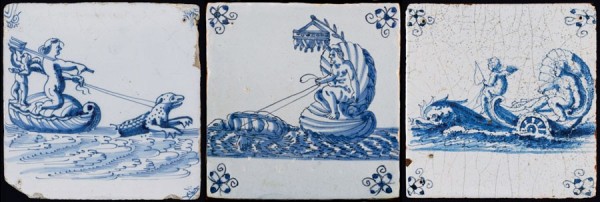
Tiles, Holland. Delftware. Left: Ca. 1660–1700. 4.92" x 4.91" x .35". Neptune bearing a trident is shown here riding on a closed seashell drawn by a scaly leopard whose head and shoulders are stippled. Behind Neptune stands a winged Nereid holding a small flag. The sea ripples to the right. The clay is yellow, the edges beveled; there are two pinholes .39" in from the oxhead corners. On the back, drawn in cobalt, is a large “64,” probably a dealer’s stock number. Center: Ca. 1630–1660. 5.11" x 5.11" (thickness concealed by a frame). Neptune rides an open seashell with an elaborate sunshade suspended over him. He holds the reins of a well-drawn turtle, the details of which are obscured by a lighter blue wash. The clay is yellow, and the figures are outlined in manganese—as is the sea, which is created from rows of zigzag lines. The spider corners are boldly executed, and there are two pinholes .66" in from them. See fig. 12 for a tile from the same factory. Right: Ca. 1650. 5.11" x 5.11" x .43". Represented here is a Triton riding on a wheeled sea chariot with a wind-baffling shell behind him, powered by a dolphin. In the chariot’s bow sits a winged Nereid holding reins and a whip. The sea is realistically treated with the crests of the waves in a reserve. The surface of the glaze is heavily crazed, pitted, and black-speckled, and there are spider corners with three pinholes well in from them. This may be an example of the surface condition that preceded the addition of kwaart. The clay, which is orange and visibly wedged, is beveled at the edges.
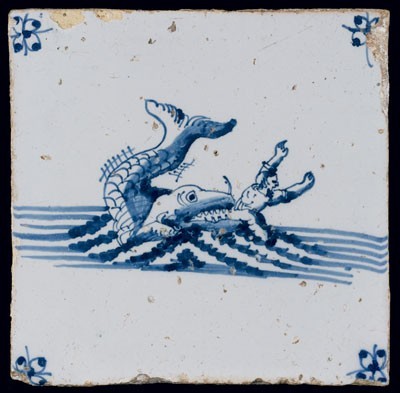
Tile, Holland, ca. 1680–1710. Delftware. 5.03" x 5.03" x .31". Jonah is shown in the jaws of a saber-toothed whale atop a chevron sea. The clay is yellow with beveled edges. Two pinholes are close to the spider corners.

Tile, Holland, ca. 1650–1690. Delftware. 4.92" x 4.92" x .39". A mer-man with a forbidding face holds a cross (crucifix?) on a hooked sea; on the horizon are two yachts. The seventeenth-century Dutch, having thrown off Catholic idolatry, produced very few religiously oriented tiles. It is tempting, therefore, to see this grim merman as the personification of Catholic oppression. The clay is yellow, with beveled edges; two pinholes are set .59" in from the oxhead corners. There is some sub-surface crazing of the glaze.
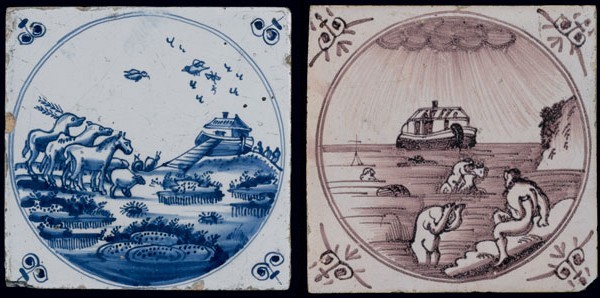
Tiles. Delftware. Left: Probably London, ca. 1720–1740. 4.96" x 5.04" x .31". An English approach to the biblical flood, executed in blue. Animals, birds, and people are on their way to the ark as water rises in the foreground. The design is framed within two concentric circles and the corners are a rare stylized and hornless version of the Dutch oxheads. The clay is a sandy yellow, the edges are not beveled. There are four pinholes inset from the corners. Right: Holland, ca. 1800. 5.07" x 5.07" x .27". A less optimistic, Dutch version of the biblical flood executed in manganese, featuring the ark, the spire of a submerged church, miscellaneous floating debris, a man perhaps riding a sea horse, and, in the foreground, two despairing people—all within double concentric circles and oxhead corners. The clay is pinkish yellow, with beveled edges, and the glaze is tinted a pale purple by the manganese.

Tile, Holland, ca. 1660–1680. Delftware. 5.11" x 5.11" x .39". Left: The front shows a figure of uncertain sex who carries a spear and rides on a stylized strip of ocean. Right: The back is ornamented with enigmatic doodles, the largest being the letters SHI, which, if viewed in retrograde, would read IHS but for the S being reversed. The possible Christian symbolism is enhanced by reading the upper doodle as a cross drawn up out of the H. The fact that it is capped with a sunflower(?) and has one bird sitting on the lateral bar and another falling off it does not lend itself to such an interpretation, however. The two objects under the SHI might or might not be dice.
The front and back of this tile are poorly painted, the deep cobalt blue speckled and cracked beneath the glaze. The clay is pink with iron inclusions. The edges are sharply beveled, with two pinholes inset from the oxhead corners.

Tiles, Holland, 1850–1900. Approx. 6" x 6" x .27". Depicted is a pair of two-masted ketches, one with sails furled and the other under full sail; the foreground water is windswept, under realistically treated clouds. The clay is yellow with beveled edges; there are no pinholes or decorated corners.
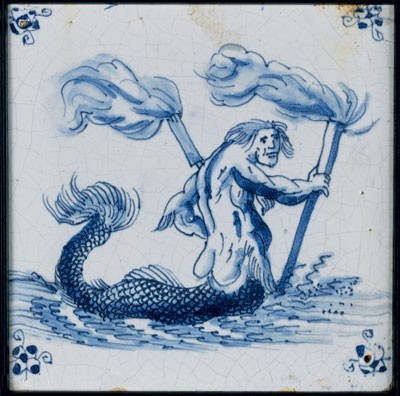
Tile, Holland, ca. 1650–1680. Delftware. 4.72" x 4.72" (thickness and body color obscured by a frame). A distraught merman is shown searching for something with a torch in each hand. He is anatomically odd in that he has a fin growing out of his right thigh and sagging buttocks resembling female breasts. The remainder of his piscine body, however, is very carefully drawn, as are the ripples around him. The tile has spider corners, two of which are pierced by pinholes.

Tile, Holland, ca. 1650–1690. Delftware. 4.96" x 4.96" x .19". A determined-looking merperson with an attenuated neck, straight hair, and a dish-shaped hat, is squirting water (or milk?) from his (her?) breasts. The sea is drawn with straight lines, and possibly there is a weed-covered rock in the foreground. This most unusual figure is painted in dark blue outline and filled in with two tones of blue. Oxhead corners and two pinholes. The glaze is thick, kwaart-enriched, and heavily crazed. The clay body is a pale pink and very sandy, with slightly beveled edges. This tile is probably a product of an inexperienced factory.
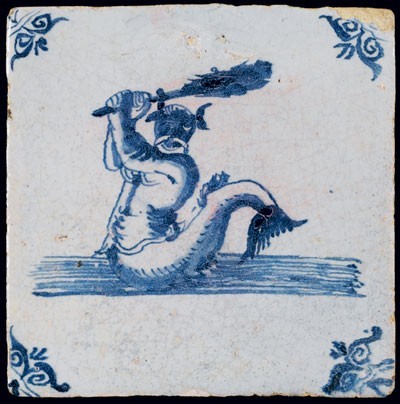
Tile, Holland, ca. 1680–1710. Delftware. 5.03" x 5.03" x .39". A demoniac merman with horns and blue-filled face is wielding a club or broom. This forbidding monster rides on a straight-line sea. The clay is yellow; oxhead corners and two inset pinholes. There is crazing in the engobe under the glaze.

Plate, Holland, ca. 1650–1700. Delftware. D. 8.42". This shallow plate has a grayish glaze and is decorated with a standing figure of Aphrodite holding a billowing sail in the same hand that clutches a tress of her hair. She stands on a pearl in the midst of a calm sea. The back of the plate exhibits three sagger pin scars. See fig. 9 for a tile that shows a comparable image but of inferior quality.

Left: Dish, probably North Netherlands, ca. 1690–1710. Delftware. D. 10.62". This dish is decorated with a mermaid in a standard pose flanked by stylized sailing vessels, painted in a rich, dark blue. In the center are triangular stilt scars, and the stepped back and foot ring are lead-glazed. Right: Tile, Holland, ca. 1720–1750. 5.11" x 5.11" x .23". Here the basic tile mermaid holds a mirror but no comb; chevron water treatment. The tile has spider corners and two pinholes close to the slightly beveled edges. Its tin glaze is a pale bluish gray and the design a weak blue, with some discoloration due to having been mounted inside a fireplace.
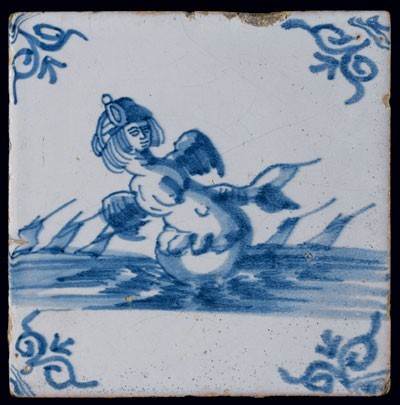
Tile, Holland, ca. 1700–1740. Delftware. 5.04" x 5.04" x .31". A winged but armless siren is wearing an elaborate cap and, below her waist, something that could be a very short skirt or four bovine udders. The figure is flanked by five sailboats, and the sea is a modified chevron treatment, presumably portraying a parting of the waves. The palette is a pale, somewhat diffuse blue. The edges are slightly beveled, and there are oxhead corners with two near-to-edge pinholes.
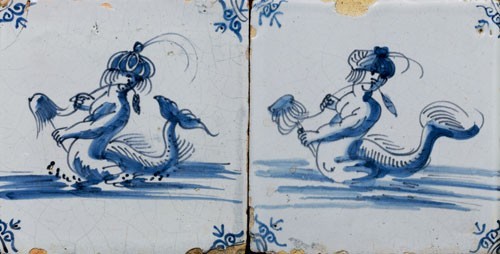
Tiles, Holland, ca. 1650–1700. Delftware; yellow clay. Left: 5.11" x 5.11" (thickness concealed by framing). Right: 5" x 5" (thickness concealed by a frame). Two treatments of the same subject, namely merpeople wearing elaborate bonnets and demonstrating how to spin flax without legs to grip the distaff (see fig. 27). The sea is treated as lateral stripes, one with spray and the other without it. There are dual pinholes set .59" in from the oxhead corners.
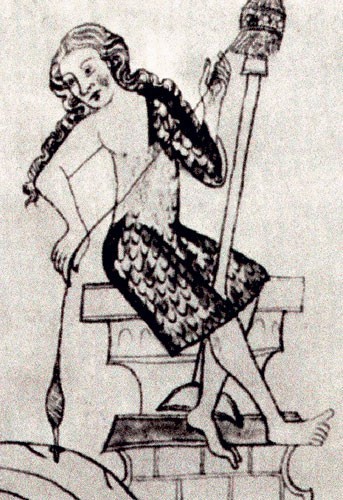
Woodcut, central Europe, ca. 1340. A woman spins with spindle and whorl, gripping the distaff between her thighs; at its top is a bundle of flax. Detail from the Velislae biblica picta, National Library of the Czech Republic, Prague.
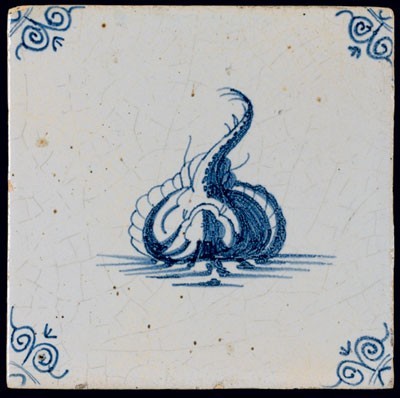
Tile, Holland, ca. 1700. Delftware. 4.92" x 4.92" x .33". Yellow clay with beveled edges; possibly kwaart sealed. The tile is decorated with a stingray in a bellicose pose, the glazed ground a pale gray and crazed beneath the surface. There are oxhead corners and only one visible corner pinhole.
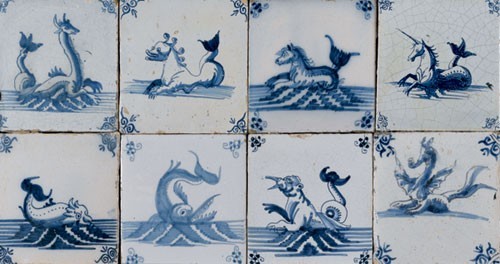
Tiles, Holland, 1640–1700. Delftware. 5"–5.11" x 5"–5.11" (thickness concealed by a frame). This eight-tile aquarium comprises a sea giraffe, two horses (one with braided mane), a unicorn, a dolphin, a shark, a walrus, and a winged dragon. Three of these yellow-body tiles have spider corners, the rest have oxheads; most have dual pinholes. The dragon has its pinholes far in from the corners (.98") and is arguably the earliest of the group.

Tile, Holland, ca. 1680–1710. Delftware. 5.04" x 5.04" x .35". A dramatic scene at sea occupies only the upper half of this tile. A departing mermaid leaves behind a drowning female wearing a black bra and water wings. A bird, probably dead, dangles from an overhead loop of string. Two of the spider corners have pinholes set .39" in from them. The clay is yellow with slightly beveled edges; the glaze is crazed and tinted blue.
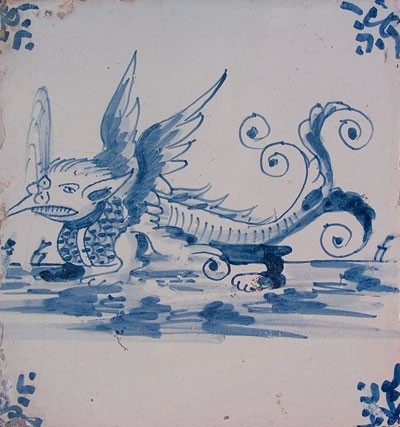
Tile, Holland, ca. 1680–1700. Delftware. 4.84" x 4.96" x .31". The head of this sea creature resembles several in the engravings of Peter Bruegel the Elder, with its pointed ears, spouting nose, and straight hair. The wings are like those of a griffin, the chest is scaled, the legs are somewhat doglike, and the tail is reminiscent of peacock feathers. A lower fin has a similarly scrolled terminal. The sea is calm and small craft sail on it, a detail not seen until the late seventeenth century. The corners show rudimentary oxheads; there are no pinholes. The pink body has slightly beveled edges; the glaze is tinted blue.
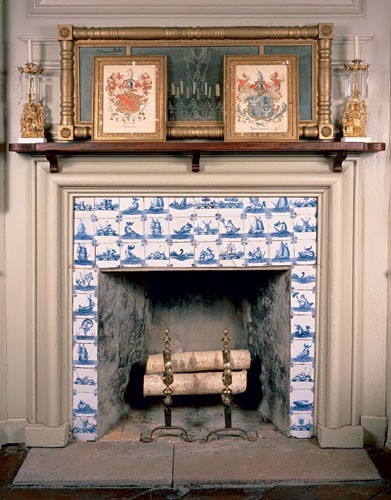
Tile-lined fireplace at the Warner House, Portsmouth, New Hampshire, built 1716–1718. These fireplace tiles, attributable to ca. 1680–1725, were probably new when they were installed. Those in the top three rows are not originally from this fireplace, although they are contemporary with it. (Courtesy, Warner House Association; photo, Douglas Armsden.)
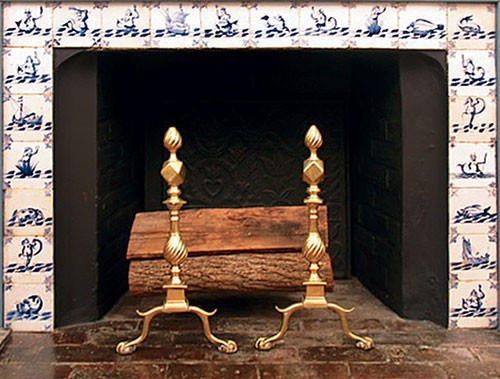
Original Dutch maritime and piscine tiles used in the re-created Dutch sitting room of a modern Pennsylvania home. (Photo, Ivor Noël Hume.)

Bathroom at the home of the author, decorated with Dutch delftware tiles that were reproduced from originals in the collection. All are attributable to ca. 1650–1700, with the exception of the ship panel, which was copied from a ca. 1800 pair removed from a Dutch farmhouse.
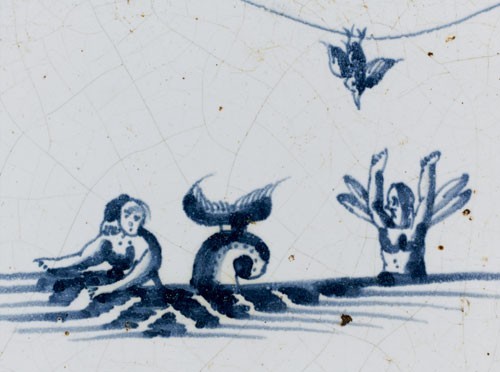
Detail of the tile illustrated in fig. 30.
No one collects anything without reason, without a catalyst. My introduction to Dutch tin-glazed maritime tiles came by way of a powder horn decorated by a British soldier stationed in Jamaica. An amateur naturalist, he had engraved the horn with the various creatures he saw there, among them a manatee, which he took to be a mermaid (fig. 1). That led me to Columbus’s log and his mermaid sightings, and thence into the deep waters of Poseidon-related mythology.
The pleasures of collecting are driven by perception, in my case by a quirky way of looking at sea-related delftware tiles. Some may see them as attractive (or maybe peculiar) wall decoration, but to me each one is a picture from the past, painted by someone who transferred his thoughts and talents to a square of whitened clay. I reach out to him, trying to imagine whether he was hot or cold as he worked, whether he was well or ill fed, and how he got along with his wife. Indeed, was he even a he? Such musings, though perhaps not typical of most academically trained curators, add a dimension to each tile.
Using tiles for flooring material is as old as using clay slabs in roofing. But it was not until the Middle Ages in Europe that tiles became elements of paving decoration, at which time they were small, thick, and decorated by means of incuse ornamental stamps whose impressions were filled with white clay before being lead glazed. Being subjected to heavy traffic, these tiles would have quickly lost their decoration had it been painted on the surface of the clay. Besides, the white clay (later used in tobacco-pipe making) was expensive. By the fourteenth century the white clay was spread over the surface of the stamp and impressed onto the tile in the manner of block printing. One such printed tile was impressed with the figure of a mermaid and survives in a library floor in England’s Litchfield Cathedral (fig. 2). It is, however, a rare exception, as the majority of medieval tiles are heraldic in style.
The art of decorating ceramic tiles with oxide of tin over a white engobe spread across Europe in the early sixteenth century as a result of trade with the Ottoman Empire. Ambassadors and traders saw newly built mosques and palaces decorated with gleaming tiles painted under the glaze in blue (and later with red and green) that were vastly superior to the Byzantine-inspired floor mosaics of European churches and abbeys. However, the Ottoman (Iznik) tiles covered walls, ceilings, domes—indeed, anything above the floor. Contemporary European tile makers were eager to learn the mystery of what eventually would be known as delftware, but were content to make their tin-glazed tiles for use on floors.[1] Thus, the first potters in England to make the new tin-glazed ware were reported in 1567 to have “followed their Trade, making Gally Paving Tiles,” which were thick but not very durable.[2]
Potters Jasper Andries and Jacob Janson were Protestant Flemings who fled to Norwich from Antwerp to escape Spanish-Catholic persecution. It was inevitable, therefore, that their products would emulate those they had been making in the Netherlands. Being intended as floor mosaics the tiles came in units of four to create repeating designs, commonly featuring pomegranates and grapes (both fruits being biblically associated with the seeds of fecundity) and Dutch tulips (fig. 3). Whether the potters who made the tiles or the people who walked on them were aware of the iconography is anybody’s guess. It is, however, a fact that the decoration was used on both sides of the North Sea from about 1570 to 1620. By the latter date the Dutch and Flemish potters were emulating their Ottoman confreres and looking upward from the floor to walls, stoves, and fireplaces.
These tiles, having become purely decorative, could be made with less clay and their painted surfaces lent themselves to more imaginative designs, thereby opening up a huge industry that lasted through the eighteenth century. But not so in England, where production of decorative paving tiles came to an end about 1625 and did not reemerge as wall tiling until late in the 1670s. Documentary records show that even then the English manufacturers were having trouble producing tiles capable of competing with the burgeoning Dutch industry.[3] When eventually they were successful, contemporary taste called for a uniformity of biblical or landscape designs contained within two concentric circles. The common corners of early Dutch and, later, English tiles are classified by collectors as “oxhead” and “spider,” though neither name really describes those often slapdash devices which when four tiles were placed together continued to create repeating patterns.[4] The large panel illustrated in figure 4 demonstrates how, even when tiles painted with differing subjects were mounted together, their corners provided a uniformity of design.
It is not my purpose, however, to pursue the evolving design elements and processes that are already well known to collectors of English tiles. Suffice it to say that merpeople are absent from English tile designs in the seventeenth and eighteenth centuries. In America the market preference is reflected in a New York dealer’s 1764 advertisement for “A Few very neat Scripture and Landskip Chimney Tiles.”[5] Even ships are few and far between, probably because the vast majority of the population had no contact with the sea. The Dutch, on the other hand, had difficulty keeping away from it. As their livelihoods depended on deep-sea fishing and an international carrying trade, it made sense that ships were a popular subject for tile painters.
Indeed, they continued to be so well into the nineteenth century, both for individual tiles and as elements in eight- and ten-tile panels.[6] The depictions were sometimes very carefully done, enabling the buyer to identify a wide range of sailing vessels, from galleons and coast-hugging ketches to rowboats (figs. 5, 6).[7] The ships, which can be identified by their national flags or pennants, are invariably Dutch. For seafaring collectors, ship tiles can be a category unto themselves. For me, however, what might lurk beneath the waves has been my primary fascination.
Ever since we humans grouped ourselves into tribal units aspiring to a degree of civilization we have embraced the notion that there were gods to watch over our houses, our crops, and our children, and to take the blame when things did not work out the way we expected. We believed that these gods had to look like us—or at least partially like us. Thus, Poseidon, the god of the ocean, had a human head and torso (fig. 7), whereas the rest of him could be, but not always was, fish. It goes without saying that his wife, Amphitrite, was similarly constructed, her piscatory parts sometimes kept demurely below the surface of the sea. They had numerous progeny, the best known being Triton, whose nether parts were shaped like the tail of a dolphin and whose principal activity was blowing into a twisted seashell—violently, to summon storms, or gently, to calm the waves (fig. 8). Thus wrote the Roman poet Ovid:
Already Triton at his call appears
Above the waves; a Tyrian robe he wears,
And in his hand a crooked trumpet bears;
The sovereign bids him peaceful sounds inspire,
And give the waves the signal to retire;
His writhen shell he takes, whose narrow vent
Grows by degrees into a large extent.[8]
Over time there came to be many second-string gods named Triton, some of them possessing the forelegs of a horse. (Among his many other attributes, Poseidon was the god who smote a rock with his trident and thereby gave birth to creatures half horse and half human.)[9]
The deital ideas of the Greeks were repackaged by the Romans, who passed them off as their own. Thus, Poseidon became Neptune and Amphitrite became Salacia, goddess of salt water. Her name became synonymous with salaciousness and explains why supporters of Queen Elizabeth I drew cartoons of Mary Queen of Scots as a whoring mermaid. Also of Greek ancestry was Aphrodite (fig. 9)—Venus, to the Romans—who was one of an abundance of sea-dwelling daughters of god and goddess Nereus and Doris. These sisters came to be known as Nereids, nubile maidens given to cavorting amid the waves and helping sailors in perilous waters, but that is deeper than we need dive into remote mythology. My point is that between them the Greeks and Romans created an undersea world recognizable to Dutch tile painters and, presumably, to the good citizens of Holland who mounted them on their walls.
Being a practical people, the Dutch tile makers assumed that human relationships in the undersea (or on-the-sea) world behaved as they did in burghers’ bedrooms (fig. 10). The Victoria and Albert Museum has examples of these tiles, but keeps them discreetly hidden in a drawer![10] The Dutch evidently did not consider them prurient, but simply the natural precursor to my next examples (fig. 11), which show what might be Salacia suckling her infant and Father Neptune holding up his Triton pup in a failing attempt at house-training. It can be difficult to distinguish between Neptune and his sons, who were prone to fighting amongst themselves (fig. 12) or behaving as classical prototypes for jet ski hooligans (fig. 13).
Depictions of godly vehicles are relatively common. They usually take the form of seashells drawn by sea stags, sea horses, and turtles, or by the dolphins mythologically associated with Poseidon—he being a powerful, sometimes warlike figure, and his dolphins the embodiment of serenity at sea. Now and then the beasts had the benefit of wheels (fig. 14, right).
Unlike the more common terrestrial tile designs, recognizable biblical sources are few. The only such motif known to me is that of Jonah and the Whale (fig. 15), and only once have I seen a merperson carrying a Christian cross (fig. 16). Later, however, the story of Noah and the biblical flood would be used as one among the many circle-enclosed scriptural subjects. On the left in figure 17 is the English version and on the right the Dutch—a demonstration of how difficult it can be to tell one from the other.[11] Both date between about 1720 and 1800 and do not really fit within my classification of maritime tiles, very few of which date any later than the end of the seventeenth century.
Dating within the seventeenth century is difficult once we get past the thick paving tiles, which, as I have noted, were over by about 1620. As none of the wall tiles bears a date, one has to rely on previous pundits, who might have been wrong. There are, however, distinct stylistic differences, particularly in the treatment of water, varying from narrow bars to flowing chevrons and individual waves. The painters’ differing treatment of the waves can be clues to dating associations, as can their methods of depicting merpeople’s piscine scales, although it is doubtful that they represent an evolutionary sequence. On the contrary, they are more likely the product of several designers and painters in different factories. Although corner motifs got smaller the more they got away from four-unit paving tile compositions, the ubiquitous oxheads continued on through the eighteenth century, as did the so-called spider elements. Thickness, however, is a relatively reliable guide—the later they dated the thinner they were made. Chamfered edges are often encountered from about 1630 through the nineteenth century, the beveling designed to enable the faces of the tiles to fit snugly together while allowing maximum space for mortaring the back edges.[12] However, these details are also more likely to represent products of different factories than of date.
Very rarely were tiles marked or painted on their backs, although exceptions occur in all periods when numbers were applied to identify each tile’s placement within large panels, an important assistance when each tile represented, say, two letters in a trader’s advertisement or no more than a tree branch in a landscape constructed of a hundred or more tiles.[13] In the eighteenth and nineteenth centuries, pattern and batch numbers were sometimes applied, and now and then bored painters doodled on the backs. Figure 18 is a rare early exception, on which the apparently religiously motivated artist drew a cross and the Christian IHS in retrograde—along with much else that now makes no sense. Another, perhaps unique, Dutch tile of about 1635 is inscribed “WIT SONDER QAERT,” meaning without kwaart.[14]
The words provide a convenient segue to saying more about tile manufacturing. Kwaart in Dutch means to cover, in this case a covering of silver sand and lead oxide applied after painting to give the surface a bright, transparent lead glaze. By the mid-seventeenth century, however, the makers had discovered that by adding lead silicate to the underlying tin-enriched engobe, the second step could be avoided—hence the back notation “WIT SONDER QAERT.” Experiments with different clays continued, but by the end of the century the early red-firing brick clays had been abandoned in favor of denser, yellow-firing clay. This thinner, first-fired (1,020°C) biscuit stage was then coated with the white engobe on which the decorator painted. That done, the tiles were refired standing on edge and back-to-back in a glost oven at a temperature of about 900°C. In theory the finished tile would emerge with both glaze and decoration bonded into the biscuit. But failures were frequent. Glost firing at too high a temperature causes the glaze to bubble and sag, distorting the painted design in the process. The image illustrated on page 253 of this volume (Beverly A. Straube, “A ‘Wretched Tile’ from Jamestown,” fig. 1) demonstrates that misfires that should have been discarded as wasters reached Jamestown, Virginia, as scarcely acceptable seconds.
The first step in tile manufacturing called for flat sheets of the prepared clay to be air-dried to the leather-hard stage, at which time a square board edged with iron was laid on the clay as a sizing template. To prevent slipping on the still damp clay, small nails were driven through the corners of the template, creating tiny holes still visible in the corners of the finished tiles. Dutch authorities have stated that four securing nails set well in from the tiles’ corners were the norm from about 1550 to 1650. The number of nails was later reduced to three or two and set closer to the edges. In the never-ending quest for dating criteria, one is prone to take the nail (or pin) hole feature as holy writ. Wrong again. When the holes were shallow, they could be obscured by the engobe. Three-hole examples occur in the second half of the seventeenth century, and two-hole ones on and off through the eighteenth. Some seventeenth-century tiles exhibit no holes at all. Nevertheless, it is fair to say that, in general, four holes in from the corners indicate an earlier date than fewer closer to the edges.
Seventeenth-century wall tiles usually measure about 5 by 5 inches, but some of the earliest, particularly those on red-firing clay, are slightly larger (5 1/8 by 5 1/8 inches). To achieve those dimensions there had to have been two stages of shrinkage, the first driving out 20 percent of the moisture from the leather-hard unfired clay, and the second during glost firing, together amounting to an 8 percent reduction. In the eighteenth and nineteenth centuries tiles became appreciably larger, averaging 6 by 6 inches (fig. 19).[15] The thickness was reduced from an average of .39 inches in the seventeenth century to .27 inches in the eighteenth.[16] The difference is a fairly reliable means of distinguishing between early and late—with emphasis on fairly.
From first to last the tiles’ decorative designs were applied with the aid of stencils that enabled specks of charcoal to provide outlines. The painters then connected the dots and subsequently filled in the details by hand. However, I believe that an experienced tile painter could, and did, create the simpler mermaids and fish solely by eye. To my knowledge no pattern books from the seventeenth century survive, and it is uncertain who drew the designs that then became stencils. Some inspirations almost certainly came from ornamented sea charts, some from contemporary engravings, others from fish sold in the markets or salvaged from the memories of bibulous sailors. But more challenging are the multitude of figures holding incongruous objects, such as the old man brandishing two flaming torches (fig. 20). Is he, perhaps, Hephaestus, the Greek god of fire whose mother, Hera, threw him into the ocean? Or is he a brother who was said to have scared off assailants by waving firebrands? Who, too, is the person with the curious hat and hairstyle who appears to be squirting milk from his/her breasts (fig. 21)?[17] Then again, the dark-visaged and horned character wielding a club may be a sea devil or simply Neptune in a black and stormy mood (fig. 22).
There is, however, one classical figure about whom there can be no doubt. Although Aphrodite is remembered as the goddess of love—some of it sublime and some venal—she was born in the sea and stepped out of it onto the island of Cyprus. As goddess of the wind—and thereby of sailors—she is depicted standing on a pearl or a seashell with a sail billowing behind her (see fig. 9). Aphrodite is one of the few standard tile figures to occur on delftware plates (fig. 23). Mermaids, on the other hand, are more common, albeit divorced from any classical, mythological context (fig. 24). The illustrated tile dates from about 1720, by which time the mirror-holding mermaid has settled into a conventional pose to be flanked by the kinds of distant sailing vessels frequently seen on eighteenth- and nineteenth-century sea- and landscape tiles (fig. 25).[18]Another demonstrates how it was possible for a mermaid to spin flax, with and without the help of feet to grip the distaff (figs. 26, 27).
As common as depictions of merpeople are those of aquatic mammals and fish—some of them are readily recognizable, such as eels, cod, swordfish, and militant stingrays (fig. 28), but more speak to the mythological idea that Poseidon/Neptune’s underwater kingdom included every form of terrestrial life, among them giraffes, horses, unicorns, and an elephantine dragon (fig. 29).
And then there are those that steadfastly defy identification. This collector has no idea what to make of a bird dangling from a celestial string above a surprised mermaid responding to a drowning person wearing water wings and a black bra (fig. 30). But, as I suggested at the outset, trying to figure out what each painter had in mind is the warp if not the weft of maritime tile collecting. Figure 31 suggests that its painter had tired of drawing standard monsters and so built his own, multi-propellant form—with fish body, semihuman head, bird wings, animal legs and feet, and a description-defying tail.
It is unfortunate that few tile-lined or tile-framed fireplaces survive in American homes, most having been stripped out when smaller stoves and grates were installed. There is, however, a splendid example of the use of maritime tiles surrounding a fireplace in the Warner House in Portsmouth, New Hampshire (fig. 32). The house was built in 1716–1718; if the tiles were new when installed they can provide a unique dating guide for the wide range of merpeople and creatures used there. One has to be reminded, however, that antique Dutch tiles are still traded and used by collectors; a couple in Pennsylvania, for example, has used them to good effect in their “Dutch” sitting room (fig. 33). Others, such as myself, have had them reproduced to provide a satisfyingly aquatic theme for a bathroom (fig. 34) and a summer fire screen. Although the reuse of antique tiles would have pleased their seventeenth-century makers, modern antiquarian purists may be less enthusiastic. Indeed, there is much to be said for seeing the tiles as legitimate works of folk art, to be framed and enjoyed individually. Although few of us have the means to acquire a genre painting on canvas by David Teniers or a harbor scene by Willem van de Velde, a ship in full sail or a portrait of an amorous mermaid painted on clay can be ours for a relatively short song.
ACKNOWLEDGMENTS
I want to express my thanks to tile authority Jan Holtkamp in the Netherlands, who kindly reviewed my captions. In some instances his dating is more precise than mine, and what follows are those wherein we differ: fig. 3 (right), 1600–1630; fig. 5 (left), ca. 1650; fig. 8, 1650–1700; fig. 11 (left), ca. 1650; fig. 11 (center), 1650–1660; fig. 11 (right), ca. 1650–1700; fig. 12, ca. 1650; fig. 13, ca. 1650; fig. 14 (left), 1650–1660; fig. 14 (center), ca. 1650; fig. 15, 1680–1700; fig. 16, 1670–1690; fig. 17 (left), ca. 1800; fig. 17 (right), 1680–1700; fig. 21, 1660–1680; fig. 22, 1660–1680; fig. 26 (left), 1660–1680; fig. 30, 1680–1700.
I am here using the term delftware with a lowercase d unless the tiles are known to have been made at Delft.
John Stow, A Survey of the Cities of London and Westminster and the Borough of Southwark . . . , 2 vols. (London: Printed for W. Innys, 1754–1755), 2: 327.
Rhoda Edwards, “London Potters circa 1570–1710,” Journal of Ceramic History 6 (1974): 22. In 1676 a Dutchman named John Ariens van Hamme arrived in London and obtained a patent for making “Tiles and Porcelaine and othere earthen wares.” He died three years later, and nothing is known about his products. Ibid., p. 115.
Other early corner designs are a spearhead-like device described in Holland as a “lily” but in English heraldry as a fleur-de-lis (fig. 3, right), and another called “fretwork.” However, I have not seen either of those used on maritime tiles. For spiders, see fig. 5, left and center; for oxheads, see figs.5, right, and 6.
Rita Susswein Gottesman, The Arts and Crafts in New York, 1726–1776: Advertisements and News Items from New York City Newspapers (New York: Printed for the New-York Historical Society, 1938), p. 90; Andrew Marschale, New-York Mercury, December 17, 1764. See my fig. 17.
Some eighteenth-century Dutch tile pictures required as many as four hundred, whereas the largest known English panel employed a mere ninety-six. Jonathan Horne, English Tin-glazed Tiles (London: J. Horne, 1989), p. 116.
By comparison with the painters of Renaissance majolica or the artists who would work on eighteenth-century delftwares, the tile painters were a pretty unassuming lot, their artistry at best described as naive. But therein lies its appeal. See fig. 34 for a reproduced, twelve-tile ship of about 1800.
John Potter, Archaeologia Graeca, or The Antiquities of Greece, 2 vols. (Edinburgh: Stirling and Kenny, 1832), 2: 82.
These are not to be confused with another sea creature, known as a hippocampus, which was half horse and half fish.
Ivor Noël Hume, “The Mermaid Mystique,” in In Search of This and That (Williamsburg, Va.: Colonial Williamsburg Foundation, 1996), p. 89.
Eighteenth-century London shopkeepers were happy to sell both together. On August 17, 1745, Hannah Ashburner at the Sign of the Rose at the corner of Fleet-Bridge, advertised that her stock included “English & Dutch Tyles.” Aubrey J. Toppin, “The China Trade and Some London Chinamen,” English Ceramic Circle Transactions 3 (1935), pl. xix, opp. p. 45.
Even this is not an infallible rule. In my collection is a pair of printed Liverpool tiles (ca. 1775–1780) depicting the difference between the plump British butcher and his emaciated French competitor; one has right-angled edges and the other chamfered. To further muddy the waters, beveled edges occur on some very early Dutch tiles.
Horne, English Tin-glazed Tiles, p. 119.
Jan Pluis, De Nederlandse Tegel: Decors en benamingen 1570–1930 (Leiden: Nederlands Tegelmuseum, 1997), p. 94, fig. 88b. See also Dingeman KorfSr., “Wat doen we met onze tegels,” Antiek (November 1966): 12–14.
In a letter of 1677 to Viscount Conway, Dr. William Johnson wrote about a supply of “Holland” tiles: “The way of sale of them is so much a foot, counting always four tiles to the foot, 10 inches making the Dutch foot.” Edwards, “London Potters circa 1570–1710,” p. 115, citing the Calendar of State Papers, Domestic Series, of the Reign of Charles II, 28 vols. (London: Longman, Green, 1860–1939), vol. 19 (March 1, 1677–February 28, 1678), p. 289.
The thickness of paving tiles from the late sixteenth and early seventeenth centuries could be as much as .59 inches.
Dutch hats and caps of the seventeenth century came in a great variety of shapes, but this does not appear to be one of them.
Several merperson plates were made in London (Lambeth) delftware about 1720–1730 (see, e.g., Noël Hume, “The Mermaid Mystique,” p. 90), but the figure drawing is reminiscent of late Adam and Eve chargers. Another found in excavations at London Towne in Maryland is akin to the representations of Georgian kings. Fragments of three such plates were found in a tavern site, prompting one to speculate that the tavern or inn was named the Mermaid. The figure is more Tritonesque than mermaid, lacks both comb and mirror, and wears an air of surprised puzzlement. Al Luckenbach, “Ceramics from the Edward Rumney/ Stephen West Tavern, London Town, Maryland, Circa 1725,” in Ceramics in America, edited by Robert Hunter (Hanover, N.H.: University Press of New England for the Chipstone Foundation, 2002), p. 145, fig. 25.
